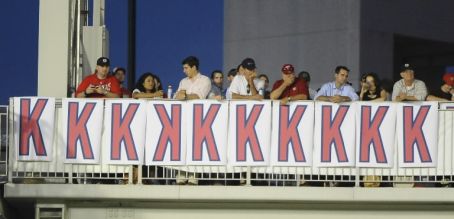The backward “K” in baseball can be seen in major league ballparks all across the country. Fans along the outfield fence will hang signs that have a “K” on them, as well as a backward “K.” What does the backward K mean, and why do teams use it?
The backward K in baseball means that the batter struck out without swinging at the third strike. The backward K is used in the scorebook to keep track of players striking out without swinging.
This article will show you what the backward K means in detail and why it became so popular in baseball.
What The Backwards K In Baseball Means
The regular “K” in baseball represents a strikeout swinging. When a player swings the bat and doesn’t make contact, or if he foul tips it into the catcher’s glove, this is represented by a standard K.
If the batter gets called out on strikes without swinging the bat on the third strike, the sign will be reversed to a backward K.
If the batter gets called looking, it often means the pitcher fooled them or perfectly located a pitch that the batter thought would be a ball.
This article will show you what the backward K means in baseball and how it’s commonly used.
How The Backwards K In Baseball Originated
The backward K in baseball originated from a man named Henry Chadwick.
Henry was a sportswriter, baseball statistician as well as a historian of the game of baseball. He’s often called the “Father Of Baseball” for all of his off-field creations to the game of baseball.
Here’s what Henry Chadwick gave to the game of baseball:
- Abbreviated The K For Strikeout
- Box Scores
- Batting Average
- Earned Run Average (ERA)
Henry Chadwick developed the box score for baseball, heavily influenced by cricket ( which he grew up playing and watching).
The letter “K” was created based on the last letter of “struck,” as in struck out. It was easy to write the letter “K” in the box score rather than write the whole term struck out.
Innovation Of The Backwards K
Henry Chadwick developed what would come to be known as the “box score” in baseball.
The box score was necessary because there were no video or audio recordings of the game in the late 1800s. The box score was the only documentation that could be found from the game.
The creation of the box score allowed players like Babe Ruth to stay relevant, even into the early 2000s. This was all because of the box score, which still greatly impacted today’s game.
Chadwick also invented numbers for positions, which is still used in today’s game to identify who’s playing where.
How important was Henry to the game of baseball? After his death, he was posthumously inducted into the hall of fame, one of very few to get in with their off-the-field efforts.
See Our Complete List Of Helpful Baseball Articles Here
Striking Out Looking With The Backwards K
Striking out looking means the player didn’t swing or even attempt to swing at the pitch. The player watched the pitch go by them into the catcher’s mitt.
This often happens because the player is either fooled at the pitch or thinks it will be a ball, so they don’t swing.
Players who strike out looking either understand that they’ve been fooled or are furious at the umpire for what they think are bad calls.
Many use the term strikeout or “punch out.” They both mean the same thing the batter missed or didn’t swing at the 3rd strike.
When a strike three is called, he can often be seen “punching out” the batter for his strike three calls. Announcers can frequently be heard and talk about “punching out” the batter on strike three.
Umpires have gone as far as improving their strike three calls, with wild, over-the-top animations to punch batters out.
Different variations started to appear as the K began to show up on more and more box score sheets.
The K was now widely used as a strikeout call, but there was no way to differentiate between a swinging strikeout and looking.
It may not make a difference to the average fan, as a strikeout is a strikeout, but to baseball statisticians, it does.
If a pitcher is so precise, it can fool the batter into not swinging. It often means their location or off-speed pitches are top-notch. This is why the backward K was invented.

As shown above, the backward K on both a box score sheet and a sign in the crowd can signify when a player strikes out looking.
Another frequently asked question is why the K for a strikeout and not the “S.” The “S,” as seen on the box score, signifies sacrifice – such as a sacrifice fly-out or a sacrifice ground-out to advance a runner.
The letters “SO” would be too crowded in the box score, so the abbreviation K was then found.
Conclusion
The backward K can be seen in ballparks all across the world. It’s a symbol for the fans to remind the pitcher and the batter how many strikeouts the pitcher has.
It’s often seen hanging in ballparks, in the outfield in big red letters.
Fans often use red or black lettering that way; everyone can see the K signs that hang on the wall. It’s a tribute to the pitcher that he’s doing a great job.
The more backward K signs on the wall, the more time the pitcher fooled the batter when striking out.
K signs have been a part of the baseball culture dating back to the early 1900s.
It will continue to be part of the baseball scoring system to signify that the player has struck out looking.
This easy grading system is seen in scoring books worldwide, and it’s become a universal language for scorekeepers to identify when a player strikes out looking.
The K will continue to signify the player has struck out, and the backward K will alert people when there has been a strikeout looking.
How do you grade for punchouts? Do you have a different way to grade your box score and put something different for strikeouts? Let us know in the comment section below!
